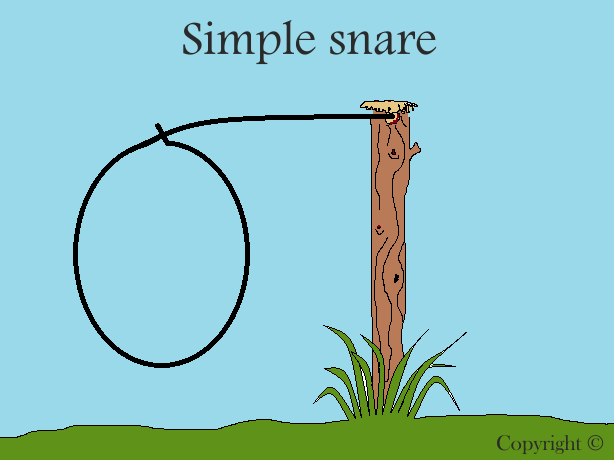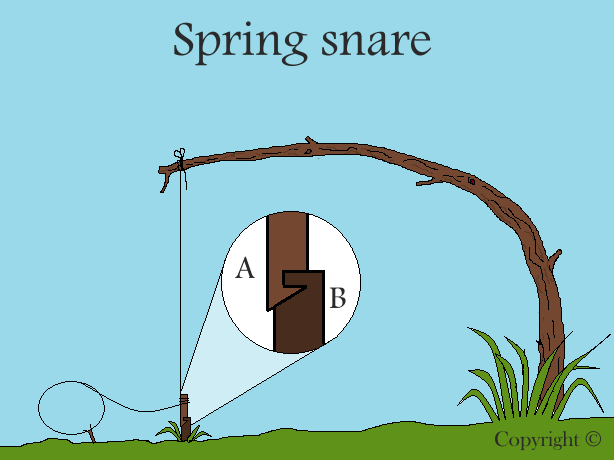Since we as a species started eating meat we began to find easier and more efficiant ways to hunt our meals.Projectiles have changed immesurably from a stone thrown by hand to the modern high velocity rifles,however the snare and spring snare have been tweeked a bit through the milenia but essentially the same item is used,originally the snare would have most likely have been a cordage made from plant fibers but at some point someone realised the potential of the brass wired snare and so it has been essentially the same snare since,some are used 'as is' suported by foliage or just the tension of the wire attached to a peg,some are used in conjunction with a tealer,this being a thick guage wire that supports the snare at what ever hieght you require.Below is a basic wire snare:

At some point one of our ancestors worked out that a snare in conjunction with a spring action was very benificial,heres a basic one,the spring snare:

Basically a sapling that is good and springy is used for the spring action,if there is one next to where you want to set a trap then thats good,but all to often there isnt one so a sapling must be cut and stuck well into the ground so that it is well heeled in around about it and firm,trim any twigs or foliage off as they would slow the 'whip' of the action when trigered a piece of cordage is tied to the end of the sapling and the other end a toggle triger (A) is attached as per the diagram,a groove carved round the string part of the toggle triger will aid the cordage in staying on without slipping off under the preasure,the other part of the trigger (B) is just a glorified peg set well into the ground to be sure it doesnt pull out under the preasure of the spring,the snare is set in the usual manner and attached to part A so when an animal gets caught its struggle will dislodge part A and in doing so realeasing the sapling ,jerking the animal clear of the gound out of the way of scavengers like fox or badger,often the neck will be broken in the initial whip,try making one for practice in your garden but dont leave it unattended !

At some point one of our ancestors worked out that a snare in conjunction with a spring action was very benificial,heres a basic one,the spring snare:

Basically a sapling that is good and springy is used for the spring action,if there is one next to where you want to set a trap then thats good,but all to often there isnt one so a sapling must be cut and stuck well into the ground so that it is well heeled in around about it and firm,trim any twigs or foliage off as they would slow the 'whip' of the action when trigered a piece of cordage is tied to the end of the sapling and the other end a toggle triger (A) is attached as per the diagram,a groove carved round the string part of the toggle triger will aid the cordage in staying on without slipping off under the preasure,the other part of the trigger (B) is just a glorified peg set well into the ground to be sure it doesnt pull out under the preasure of the spring,the snare is set in the usual manner and attached to part A so when an animal gets caught its struggle will dislodge part A and in doing so realeasing the sapling ,jerking the animal clear of the gound out of the way of scavengers like fox or badger,often the neck will be broken in the initial whip,try making one for practice in your garden but dont leave it unattended !

